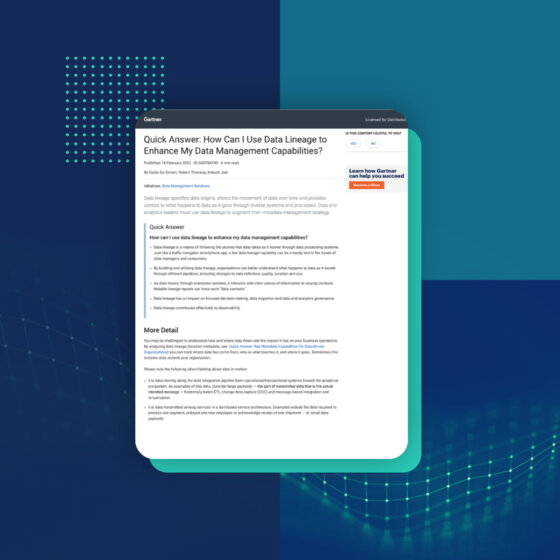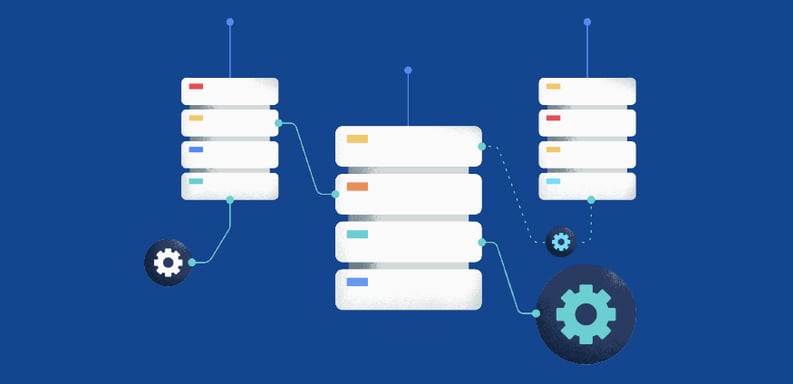
Library
Data is the backbone of every system and process in your organization – including those that are manual. Think about it: every decision being made in your organization, from budgeting to product expansion, is (ideally) data driven. However, 76% of businesses find it difficult to understand their data, according to a recent survey published in Forbes. To gain better insight into your data and use it more effectively, you must understand the value of metadata and how to use it.
Any time there is data, there is also someone creating, cataloging, accessing, and evaluating it. All of that information creates metadata, or context about data, which can create greater transparency and trust so that you can more clearly understand the data. But how do you start using metadata? The solution lies in metadata management – a powerful process that holds the key to streamlining data workflows, ensuring compliance, improving data quality, and enhancing decision-making.
In this guide, we’ll delve into the world of metadata management, exploring its diverse benefits, the challenges it poses, and its real-world applications. We’ll also take a deep dive into Manta’s automated data lineage, the leading platform that helps unlock your metadata, and explore its distinctive features that set it apart from other lineage vendors.
To begin, let's gain a clear understanding of metadata. In simple terms, metadata refers to descriptive information about data. It comes in various forms, such as data schemas, definitions, lineage, dictionaries, and more. Metadata provides essential context and insights into data's structure, origin, and flow within an organization's systems. This is a key component of enterprise metadata management.
"The challenging aspect of defining metadata is that the same data can be recognized as either data or metadata, depending on the context. For example, data models are metadata for business users. For data modelers, on the other hand, data models can be considered data that will in turn require other metadata to describe data models. Different sources contain different approaches to classifying metadata."
Metadata is essentially data about data – it provides descriptive information that helps understand the characteristics, structure, and context of the underlying data. Think of it as a set of labels that give meaning and relevance to data assets. Without metadata, data becomes a sea of numbers and letters, lacking the crucial context necessary for interpreting and utilizing it effectively. In some cases, metadata shows who modified data, when, and within which system the modification occurred.
For example, if you work in a healthcare organization, patient data is likely stored in an Electronic Health Record (EHR) system. That system not only tracks patient data, but who input the data, when, and if it was modified at any point (which is the metadata). Unlocking the metadata in healthcare through data lineage can improve patient care options and help you gain a firmer grasp on the way data moves through your organization.
Gartner defines metadata management as “a set of capabilities that enables continuous access and processing of metadata that support ongoing analysis over a different spectrum of maturity, use cases, and vendor solutions.”
Metadata management involves capturing, storing, organizing, and maintaining metadata to ensure its accuracy, consistency, and accessibility. An effective metadata management strategy empowers organizations to fully harness their data assets, promoting data quality, fostering collaboration, and facilitating data governance.
Metadata is almost everything. One obvious question is how to map ALL metadata, and whether there is even a strong business case to do so. But, before you map your metadata, you’ll need to understand what type of metadata you want to track. You can break metadata down into three categories:
Technical
|
|
Operational Metadata |
|
Business
|
| Technical metadata provides information on the characteristics of data, including an inventory of objects as tables or files, data structure and location, etc. | Operational metadata helps you understand how the data is being used and the overall data lifecycle, as well as who can access it, when and where it was created, and when it should be deleted for compliance. | Business metadata shows the business use of the data object, including reason for collection and storage, agreements, policies, regulations, governance, and consent as defined in a business glossary. |
Metadata can be created manually or automatically, depending on the software where it is first recorded. For example, an EHR system automatically records operational metadata and technical metadata. Software like Salesforce, however, allows you to input your own custom metadata, which can provide deeper insights into each element.
Metadata management ensures that all necessary metadata is captured, stored, and made accessible to relevant stakeholders. This process is vital for establishing consistency in data usage, enabling data consumers to understand the context and limitations of the data they interact with.
Both active and passive metadata add value to your data pipeline. But active metadata provides insights that passive metadata alone cannot.
Passive metadata contains basic information about data such as data profiles (business qualification, quality score, etc.) or data operational characteristics (who accesses the data, how often, popular data sets, etc.). It provides a generic overview of the data landscape, but it is static, can’t be acted upon, and won’t be of much help with providing complete visibility into complex data pipelines, unlike properly activated metadata.
Our focus in this guide is active metadata, a concept whose definition is still evolving. To help understand it, let's compare and contrast the concept with how we use data. Metadata, after all, is also just "data". Metadata management is a technology market that has existed for decades, going through various phases. The most recent phase started with the rise of data catalogs. There are more than 30 different tools out there (probably even more), and new data catalogs are created almost every month. Yet Gartner, in their Market Guide for Active Metadata, stated that "[t]raditional metadata practices are insufficient.” So what is wrong with metadata and how can activation help?
The ultimate challenge is that we are focused too much on metadata collection, which has resulted in silos of metadata. As each catalog has its specific strengths, it is not uncommon to see multiple tools implemented by one company in different business units, which then leads to a catalog of catalogs. This is funny… and useless. Like with data, just collecting it adds no value to the organization.
Using the data analogy, we typically use data in the following ways.
There are several uses for metadata across your organization. These include using metadata for operationalizing data pipelines in DataOps and unlocking insights for improved business intelligence through metadata analysis by data lineage, among others.
Use Case |
How Metadata Helps |
| Business Intelligence (BI) | In the realm of BI, metadata management plays a pivotal role in understanding the underlying data in reports and dashboards. Accurate metadata ensures that the right metrics and Key Performance Indicators (KPIs) are used, leading to more reliable insights and analyses. |
| Governance & Compliance | Metadata shows auditors when information was last edited or accessed, who has access, and when it was created. |
| Scalability & Growth | Business leaders heavily rely on accurate and timely data to make critical decisions. Metadata management empowers them with the necessary context to trust data-driven insights and identify opportunities for growth and innovation. |
| Analytics & DataOps | In the realm of analytics, metadata management helps data scientists and analysts understand the data they work with, leading to better models, predictions, and data-driven strategies. |
In the case of activating your metadata through data lineage, there are a few use cases to explore:
Using the examples above, it is clear there are benefits to unlocking and understanding metadata. However, it is just as important to acknowledge the challenges before beginning any metadata-related project so that you can address those issues early on.
Pros |
|
Cons |
|
|
At Manta, we are pioneers in the metadata space. We integrated actionable metadata years before the term active metadata was coined, and we are big proponents of an open ecosystem with standards. We are part of OpenLineage and Egeria, but those efforts are still evolving. It means that metadata vendors must negotiate and implement point integrations with every single data solution out there, which will clearly never scale.
Among the plethora of metadata management solutions available, the Manta platform stands out with its unique approach and innovative capabilities. Manta offers automated metadata management and discovery, lineage mapping, and impact analysis through both run time and design time lineage, revolutionizing how organizations handle metadata.
Manta's platform adopts an active metadata approach, continuously capturing and updating metadata from various data sources in real-time. This dynamic metadata collection ensures that organizations have access to the most up-to-date and relevant information at all times, making their lineage map highly accurate.
Powered by advanced algorithms and data flow analysis, Manta's platform automatically discovers metadata across diverse data systems and applications. This saves valuable time and effort, enabling organizations to focus on leveraging insights from metadata rather than being burdened by manual management.
Manta's platform meticulously maps data lineage, providing a clear understanding of data origins, transformations, and destinations. With the aid of impact analysis, run time lineage, and design time lineage, organizations can fully comprehend the potential consequences of data changes, thus minimizing risks associated with data manipulation.
Manta's platform boasts high levels of customization, allowing organizations to tailor metadata management to meet their specific needs and requirements. This unparalleled adaptability makes Manta a suitable solution for businesses of all sizes and industries, empowering them to optimize their metadata management processes.
In conclusion, metadata management is an indispensable component of successful data management strategies. By fully embracing and harnessing the power of metadata, organizations can navigate the complexities of their data assets with confidence. Manta's leading approach to metadata management, featuring automated discovery, lineage mapping, and impact analysis, offers a remarkable advantage for organizations striving to achieve data-driven excellence.
Effective metadata management is not merely a necessity; it is a strategic advantage that propels organizations towards sustainable growth and success. Embrace the transformative potential of metadata management and pave the way for a future where data is not merely an asset, but a catalyst for innovation and informed decision-making.
As the world embraces an increasingly data-centric approach, organizations that master metadata management will be at the forefront of innovation, setting new standards for data integrity, security, and insights. The journey to data excellence starts with metadata management – unlocking the true potential of your data and transforming your organization into a data-driven powerhouse.
To learn more about how Manta can help, get a demo.